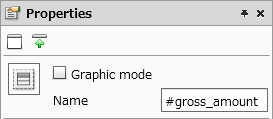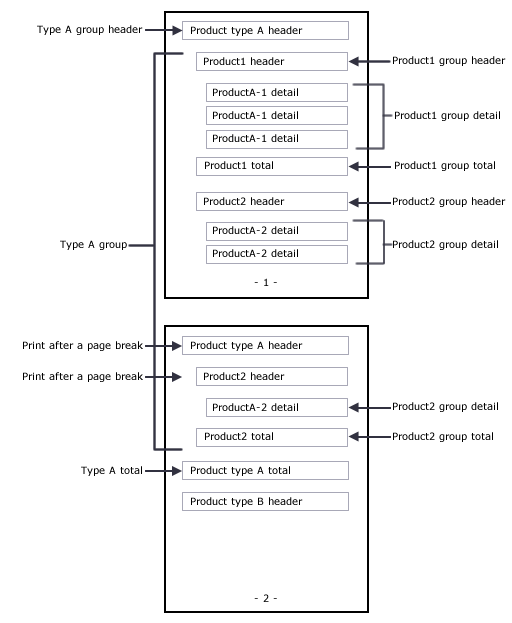4-6-10 Create records
Rows where data is iteratively output within a subform are called records. You can insert and print total lines between detail lines as needed.
Place a record
Use the following procedure to place a record:
Click the
 Create record button on the toolbox and move the pointer to any point on the Form Editor.
Create record button on the toolbox and move the pointer to any point on the Form Editor.The pointer changes to
 .
.Drag the mouse to make a rectangle on a subform, referring to the guidelines.
A record is placed.

Drag in the subform
Reference
By enabling Fit mode by clicking the
 Fit mode button on the bottom left of the screen, ruled lines and records can automatically be placed within nearby ruled lines, rectangles, or subform outlines.
Fit mode button on the bottom left of the screen, ruled lines and records can automatically be placed within nearby ruled lines, rectangles, or subform outlines.For details, see " Fit mode" in "4-3-1 Use the auxiliary features for layout".

Select the placed record and drag it to the desired position.
Set the properties for the placed record with the Property editor.
Restriction
The hierarchy is not changed even if you place a record later with items already created, or move an item that was in the form hierarchy into the coordinates of the record item later. If you want to place an item under the record hierarchy, you must create it after creating a record, or explicitly move it to place under the record hierarchy.
Set the record properties
Set the record properties. Properties are categorized as General, Line, Fill, and Multi-page.

Record properties
Reference
In the color specification field, you can select the color registered in Color palette settings in the paper Property editor. For details on how to set color palettes, see "4-11-2 Set a color palette".
Records are applied to "Fill transparent mode". For details on "Fill transparent mode", see "4-11-3 Change design colors of items".
Common settings
Item | Description |
|---|---|
Graphic mode | Specify whether to enable the graphic features. When the check box is selected, the graphic features are enabled. The Graphic mode items are added to the Property editor and you can make advanced settings. For details on the graphic mode, see "4-2 Basic mode and graphic mode". |
Name | Type a record name. If a name is not specified, it is automatically and sequentially specified from "Record1". You can use alphanumeric characters, Kana, Kanji, and underscores (_). The name can be up to 30 bytes in length. Do not use a number for the first character of the name. |
General
Item | Description |
|---|---|
Start X(dot) | Specify the X coordinate of the upper left corner of the record. You can also change the value by clicking the |
Start Y(dot) | Specify the Y coordinate of the upper left corner of the record. You can also change the value by clicking the |
End X(dot) | Specify the X coordinate of the lower right corner of the record. You can also change the value by clicking the |
End Y(dot) | Specify the Y coordinate of the lower right corner of the record. You can also change the value by clicking the |
Record type | Select the record format.
|
Print even if it does not fit in the subform | Select how a record is handled when it cannot fit into the remaining area of the subform area. This can be set when Record type is "Total record" or "Grand total record". If you select this check box, the subform area is extended and a record is printed. If you clear this check box, a page break is inserted or the rest of the record is sent to the link destination subform. 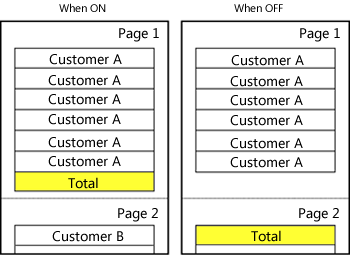 When a key break occurs on the last row |
Print at top of detail group | This can be set when Record type is "Header record". If you select this check box, the record is printed at the top of each detail group. If you clear this check box, the record is not printed at the top of each detail group. |
Print at the top of the page | This can be set when Record type is "Header record". If you select this check box, the header record is printed at the top of a new page when a page break is inserted while printing a detail group. |
Print only for multiple details | This can be set when Record type is "Total Record". If you select this check box, total records are not printed when a key break occurs on a single row. If you clear this check box, the total record is printed even if a key break occurs on a single row. |
Print only if one or more fields were modified | If you select this check box, the record is not printed unless data is output to the fields designed in the record. ReferenceHow to set a detail record not to print If you select Print only if one or more fields were modified to a detail record and select Mask for all fields created in that record, you can prevent the record itself from being printed. |
Print-control-condition | This is a feature that hides a record according to conditions. For details on output suppression conditions, see "6-6 Print-control-conditions". |
Select hatching row | Specify which rows are to be hatched.
|
Select row(manually) | When you select "Specified line" in Select hatching row, set a hatching pattern by setting 1 for rows to be hatched and 0 for rows not to be hatched. 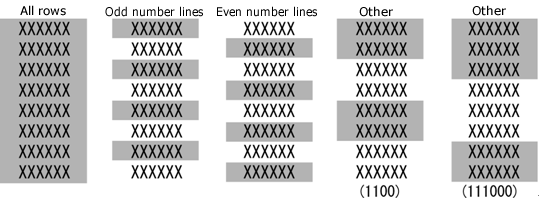 Examples of output of hatching row Reference
|
Unit of row height | Select the unit of the record height from dot, 1/6 inch or 1/8 inch. |
Row Height | Specify the row height. You can also change the value by clicking the |
Auto link-field pitch | A field whose own name is specified in its Link-field name property is called an "auto link field". If the date is output exceeding the designed number of digits, a line feed is inserted automatically in the record and the overflow data is printed on the next line. In this setting, for a record that includes an auto link field, specify the line feed pitch by the ratio to the font size of the field. You can also change the value by clicking the  Pitch and character height |
Print on fixed position | Specify whether to print a record placed outside of a subform at a fixed position. This setting is available only when record type is total record or grand total record. For example, use this function to output a total record at a fixed position on a form instead of dynamically changing its position. If you select this check box, the record is printed at a fixed position. |
Attribute-formula | Specify an attribute-formula. For details on attribute-formula, see "6-3-1 Set attribute-formula". |
Line
Item | Description |
|---|---|
Show outer frame | Specify whether to display a frame. If you select the check box, a frame is displayed. |
Line type | Select a ruled line type to print. Restriction
|
Line width | Select the line width. If you have selected Free(dot), set the line width freely in Line width(dot) shown below. |
Line width(dot) | If you have selected Free(dot) in Line width, set the line width in dots. RestrictionWhen the line is longer than 30,000 pixels, the line width may not be displayed correctly. |
Frame type | Specify the frame type from either All or Each. When Each is selected, you can specify the line type, show/hide, and the line width for each side. |
Corner type | Select the shape of the corners of the rectangle.
|
Apply corner type(upper left) Apply corner type(lower left) Apply corner type(upper right) Apply corner type(lower left) | Select the corner positions where the shape is to be changed. This can be specified only when Frame type is All. If you select a check box, the corner appears in the shape selected in Corner type. If you clear a check box, the corner will be right angle. |
Corner radius(dot) | Specify the corner radius when you select Cut, Round, or Inverted round for Corner type. |
Line color pattern (Only in graphic mode) | Specify the fill pattern of the frame. |
Hatching | Specify the tile pattern if you have selected Hatching in Line color pattern. |
Hatching line width(dot) | Set the hatching line width if you have selected Hatching in Line color pattern. |
Hatching line interval(dot) | Set the hatching line interval if you have selected Hatching in Line color pattern. |
Gradation direction | Specify the direction of the frame line gradation from the start color to the end color if you have selected Gradation2 in Line color pattern. The gradation changes depending on the end color and the type. 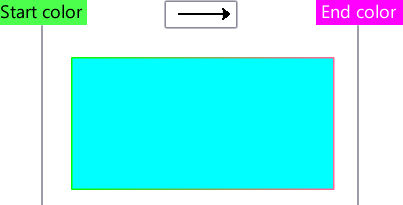 Gradation when |
Line color2 | Specify the tile line color if you have selected Hatching in Line color pattern. Specify the end color of the gradation if you have selected Gradation2 in Line color pattern. |
Fill
Item | Description |
|---|---|
Fill pattern | Specify the fill pattern of the item.
|
Grayscale(%) | Specify the grayscale depth if you select Grayscale in Fill pattern. |
Hatching | Specify the tile pattern if you select Hatching in Fill pattern. |
Hatching line width(dot) (Only in graphic mode) | Specify the tile line width if you have selected Hatching in Fill pattern. |
Hatching line interval(dot) (Only in graphic mode) | Specify the tile line interval if you have selected Hatching in Fill pattern. |
Tile image (Only in graphic mode) | Specify an image file to be output as an image if you have selected Tiling in Fill pattern. Supported image files are BMP, JPEG, PNG, TIFF, and GIF files. The images that can be output differ according to the printer model. See "SVF for Java Print User's Manual" or "SVF for PDF User's Manual". To select an image file that has been uploaded to a specified location in the form definition, select the file name from the list or type the file name directly. To select an image file that has not been uploaded, click the For details, see "4-13-3 Other files". |
Stretch image(Only in graphic mode) | When you select Tiling in Fill pattern, specify whether to output the size of the image to fit the record. If you select this check box, the image is enlarged or reduced according to the record size. If you clear the check box, the image appears at its original size and only the part in the rectangle is output. |
Gradation start color (Only in graphic mode) | Specify the start color of the gradation if you select any of the gradation patterns from Gradation1 through Gradation5 in Fill pattern. |
Gradation end color (Only in graphic mode) | Specify the end color of the gradation if you select any of the gradation patterns from Gradation1 through Gradation5 in Fill pattern. |
Gradation start color X(dot) (Only in graphic mode) | Specify the X coordinate of the start point of the gradation if you have selected Gradation1 in Fill pattern. |
Gradation start color Y(dot) (Only in graphic mode) | Specify the Y coordinate of the start point of the gradation if you have selected Gradation1 in Fill pattern. |
Gradation end color X(dot) (Only in graphic mode) | Specify the X coordinate of the end point of the gradation if you have selected Gradation1 in Fill pattern. |
Gradation end color Y(dot) (Only in graphic mode) | Specify the Y coordinate of the end point of the gradation if you have selected Gradation1 in Fill pattern. |
Cyclic (Only in graphic mode) | Specify whether to set the gradation to be cyclic if you select Gradation1 for Fill pattern. Select this check box to set the gradation as a cyclic. |
Gradation type(single direction) (Only in graphic mode) | Specify the direction of the gradation from the start point to the end point if you have selected Gradation2 in Fill pattern. |
Gradation type(cross) (Only in graphic mode) | Specify the gradation pattern if you have selected Gradation3 in Fill pattern. |
Circular gradation center X (dot) (Only in graphic mode) | Specify the X coordinate of the center of the gradation if you have selected Gradation4 in Fill pattern. |
Circular gradation center Y(dot) (Only in graphic mode) | Specify the Y coordinate of the center of the gradation if you have selected Gradation4 in Fill pattern. |
Circular gradation radius (dot) (Only in graphic mode) | Specify the radius of the gradation if you have selected Gradation4 or Gradation5 in Fill pattern. |
Multi-page
Item | Description |
|---|---|
Line color of page n ("n" is any number) | Specify the frame color of the record for each page. For details on the print colors, see "4-11 Color setting for items". |
Fill color of page n ("n" is any number) | Specify the fill color of the record for each page. For details on the print colors, see "4-11 Color setting for items". |
If you select line specification in the record property Select hatching row, whether the line to be hatched is the target line is determined by the number of records to be placed starting from the following three points:
Page top
Header record
Total record
This behavior also applies to cases where hatching is specified for multiple records. In this case, whether the records to be output are hatched or not is determined by the number of rows on that page.
The following is an output example when even lines are hatched for all three detail records.
Example: The count for hatching is cleared every time the page changes.
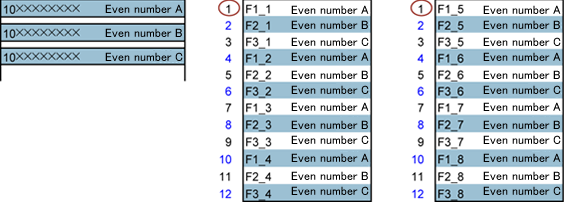
When a record other than a detail record is inserted, the count is cleared. The count starts again from one at the next row.
The following is an example output when a total record is inserted by key break.
Example: The count for hatching output is cleared with the insertion of a total record. The following output image is the total record created as two lines of detail records.

Enlarge or reduce a record
You can change the area size by enlarging or reducing a record.
Select a record and move the pointer near the square handles displayed around the record.
The pointer changes to
 .
.Drag the mouse in the desired direction referencing the guidelines.
The area size is enlarged or reduced.

Area size is enlarged in the drag direction
Place a new item in a record
When new items are placed in a record, a hierarchical relationship is automatically created and set to fit within the area of the record.
To manage this hierarchy, select Hierarchy in the Items window. The tree that represents hierarchies is called the "hierarchy tree".
For example, if there are no items in the record, the hierarchy tree looks like this:

Record is placed in a subform
Reference
A record is always created inside a subform area. Hence, it is also always placed under a subform in the hierarchy tree.
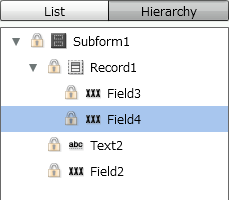
Place items in a record
If the item is under the record hierarchy, it will be output each time the record is printed. When an item is removed from under a record, it is only output in the designed position even if it is placed within the record area.
Reference
Items placed under a record in the hierarchy tree cannot be moved out of the record area in the Form Editor.
To move an item under a record out of the record area, drag the item while pressing CTRL.
Caution
When you delete a record under which items are placed, the confirmation message "The selected item contains sub items that will also be deleted. Do you want to proceed?" appears.
When you click the Yes button, items placed under the record hierarchy will also be deleted.
Remove an item from the record hierarchy
You cannot move an item under the record hierarchy outside the record area. To move outside a record area, you must remove the item from under the record in the hierarchy tree in the Items window.
Reference
When items are placed under a record, the items are also output each time the record is printed. If an item is removed from the record hierarchy, it is only output in its designated position, even if it is placed within the record area.
Select an item to place outside a record area in the hierarchy tree and click the
 Move to another level of the hierarchy button.
Move to another level of the hierarchy button.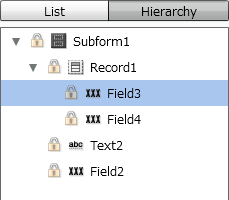
Select an item to place outside a record area
In the Move to another level of the hierarchy dialog, select None, and click the OK button.
The selected item is placed at the same hierarchical level as the subform.
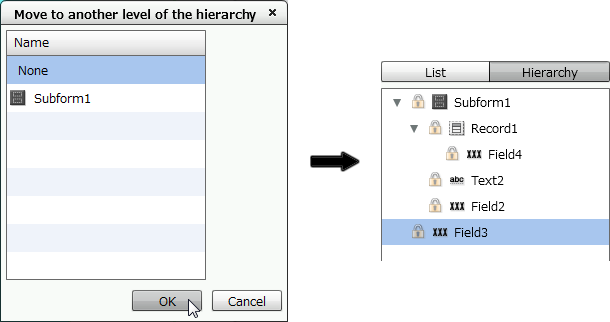
When you select "None" in the "Move to another level of the hierarchy" dialog (left), the item is removed from the record hierarchy (right)
Reference
Items removed from under a record in the hierarchy tree can be moved out of the record area in the Form Editor.
Place an existing item under the record hierarchy
To place an item currently placed outside of the record area to the record hierarchy, use the hierarchy tree.
Reference
If the item is under the record hierarchy, it will be output each time the record is printed.
Select an item to place outside a record area in the hierarchy tree on the Items window and click the
 Move to another level of the hierarchy button.
Move to another level of the hierarchy button.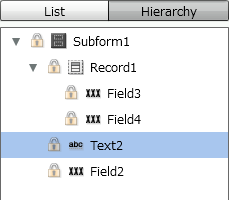
Select an item to place under a record
Select a desired record from the Move to another level of the hierarchy dialog and click the OK button.
The selected item is placed under the record.
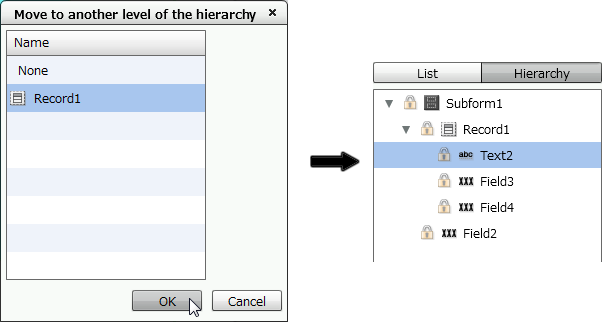
When you select a desired record in the "Move to another level of the hierarchy" dialog (left), the item is placed under the record (right)
Reference
Items placed under a record in the hierarchy tree cannot be moved out of the record area in the Form Editor.
To move an item under a record out of the record area, drag the item while pressing CTRL.
Restriction
In a hierarchy tree, items can be placed under the hierarchy only in subforms, records, and formcopies. It cannot be placed under the hierarchy of other items.

